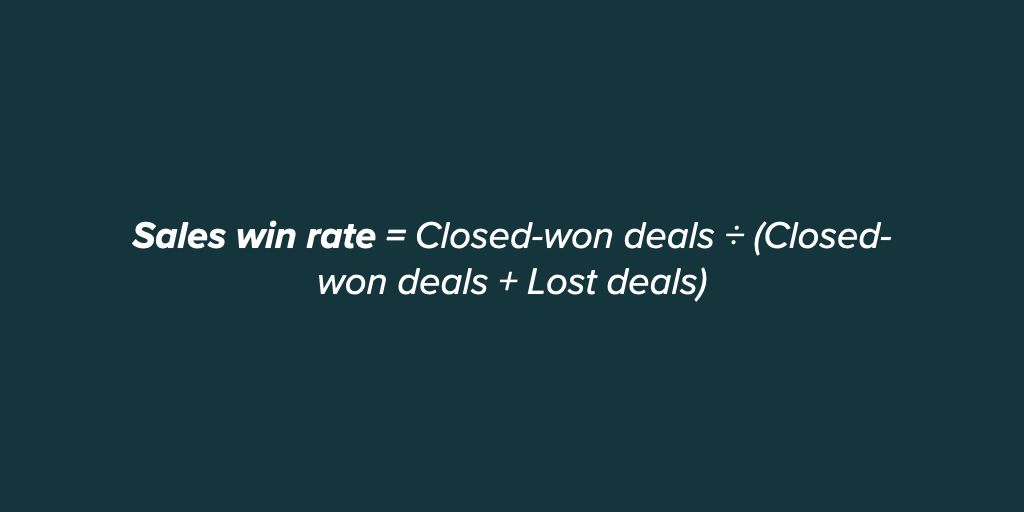Article • 9 min read
Sales win rate: How to calculate and improve it
Win rate is a key metric for measuring sales success. Every sales leader should know how to calculate it and what they can do to increase it.
Par Donny Kelwig, Contributing Writer
Dernière mise à jour March 8, 2022
Key performance indicators (KPIs) are critical measures of performance for sales teams. They can evaluate the efficiency of a sales funnel, assess the effectiveness of outreach methods, and even identify the number of emails reps send out in a given week. But no KPI receives more attention than the sales win rate.
Win rates reveal important details, including which sales tactics work best, which areas need improvement, and which products or services generate the most sales.
In this article, we’ll review the definition of a win rate, explain how to calculate win rate, and describe the steps you can take to improve your sales win percentage.
What is a win rate in sales?
Sales win rates—sometimes also called win percentages—represent the percentage of deals that closed. They help gauge a sales rep’s overall performance in a given reporting period.
There are two types of win rates that sales teams use. The first type is calculated based on the number of deals won out of the total number of sales opportunities. This ratio helps you determine whether your marketing and sales efforts are targeting the right prospects.
Some sales teams use the second type of win rate, which doesn’t include all opportunities. It excludes unqualified leads. These are potential customers who saw a demo, quote, or sales pitch but decided not to make a purchase—from you or your competitors. Using this win rate formula allows you to focus on how to convert qualified leads and to get a better idea of how you perform compared to the competition.
Why is sales win rate important?
Win rates give sales teams more visibility into the practices that are working and the ones that aren’t. The metric provides insights into which strategies, sales reps, and time periods are more likely to turn a prospect into a customer.
Sales win rates can also indicate whether businesses are going after the right buyers in a given market. For example, if a company’s win rate is low, it can mean one of two things. Either their sales team is underperforming and needs a course correction, or they’re targeting prospects that aren’t a good fit for the product or service. Now the company has an idea of what the issue might be and can investigate further before making the necessary adjustments.
How is win rate calculated?
There are different ways to calculate win rate, as certain companies may choose to include some variables and exclude others. But the basic equation remains the same:

If you’re calculating win rate without proper sales technology, you can simply divide the number of closed-won deals by the total number of deals you had in the pipeline.
Say your team won 20 clients in a given quarter and lost 30 clients in that same period. You’d plug those numbers into the equation above to determine your win percentage.
You can also use spreadsheet programs like Microsoft Excel to quickly calculate win rates for your entire team and individual reps.
How to calculate win rate in Excel
Let’s use the same example and plug the information into Excel. Place each data set in a unique cell—for instance, “closed-won deals” in C3 and “lost deals” in C4. In another cell, input the sales win rate formula using the cells with your data. In this example, it would be C3÷(C3+C4). Quick and easy.
Even though the formula is simple, organizing the data can be a different story. If you’re tracking all your sales data without the help of sales reporting software, calculating your win rate can become a time-consuming task and even lead to costly errors.
When you have a strong CRM, it’s much easier to track your prospects and overall opportunities. You can also use your CRM to calculate your win rates and other sales metrics, so you can determine which techniques and strategies give you the highest probability of success.
No matter how you choose to calculate your win rate, there are some best practices you’ll want to follow so you can fully understand what it means.
Define your reporting period
Win rates are excellent sources for course correction as well as learning opportunities for your reps. But without the proper context, statistics and data can be misleading, causing sales teams to jump to incorrect conclusions.
By narrowly defining the time period in which you calculate your win rate, you can interpret it with the correct context. Was there an external event such as a supply-chain delay that hurt your win rate? A change in legislation that affected your prospects’ purchasing incentive?
Keeping your reporting period to a single quarter or month helps you see patterns that provide insights into your current sales strategy and how it performs under specific conditions.
Identify your win rate criteria
In addition to defining your reporting period, you’ll need to choose your win/loss criteria. Win rates are great for sales analytics on overall team performance, but they can also suggest ways individual reps can improve their strategy.
To take full advantage of win percentages, sales reps need to keep track of their sales data for each account so they can better understand why some prospects purchase and others don’t. Once they know which sales techniques result in the highest win rates, they can hone in on those tactics to convert even more prospects into paying customers.
Unlock a measurable sales pipeline
This free guide examines three vital steps to establish a measurable sales pipeline that drives repeatable, predictable sales growth.
There are many reasons why prospects choose not to make a purchase, but they often fall into four main categories:
- Timing: The prospect may be interested, but perhaps it isn’t the right time for them to invest in the product or service.
- Value: The prospect didn’t believe they needed the product or didn’t see the value in it.
- Price: The price of the product or service exceeded the prospect’s budget or what they were willing to pay.
- Competition: The prospect decided to go with another company.
By using the above criteria, sales teams can gain a better understanding of the reasons deals are lost (or won).
How do you improve sales win rate?
Seeing less-than-stellar results? Follow these four tips to increase your win percentage.
Remove roadblocks
When a prospective customer reaches the final stages of the sales funnel, it can be frustrating for a roadblock to suddenly stop the sale. There are numerous resources that go into each sale—marketing efforts, strategy, time, and money—and there’s no opportunity to recover any lost resources. So when you’re communicating with prospects, don’t let your high hopes blind you to any red flags or obstacles that might cause problems down the line.
For example, if your contact isn’t a decision-maker at their company, loop in the person who has decision-making power as soon as possible. If they don’t find your product or service necessary, you won’t have to waste resources driving them through your sales funnel. If they do see value in your offering, they’ll likely be willing to partner with your company later in the sales cycle.
When you anticipate and remove the roadblocks you and your prospects might come across in the future, you lower the risk of using resources on a sale that won’t go through.Analyze win-loss scenarios
As we mentioned earlier, outlining your team’s win-loss criteria is a crucial step in optimizing sales win rates. It helps you learn why some sales techniques are successful and where to implement changes.
Sales leaders can evaluate win rates to see how their reps perform with clients in certain industries or at different price points. By analyzing these statistics, leaders can form strategies around their team’s performance and course-correct to fill in any gaps.Establish clear timelines
Miscommunication and scheduling conflicts can drag out the selling process or cause clients to lose interest in a product or service. If you’re looking to close more sales, it’s important to set expectations and clarify the next steps with prospects.
For example, a rep can schedule a call with a prospective buyer between each stage in the sales process to establish how they’ll get to the subsequent stage. The call can also serve to answer any questions the client has about the product before they make their decision. And if the customer continues to the next stage before the call occurs, then the rep can just cancel it and schedule the following one.
When you’re trying to win a deal, consistent communication allows you to follow up with your client and stay top of mind. Using customer relationship management software makes it much easier to maintain and monitor this line of communication—who wants to organize countless contacts and customer conversations using email and a spreadsheet?Know what your prospects want—don’t guess
You always want to target a prospect’s pain points by offering a solution that will alleviate them. So when you’re selling to a client, you want to know as much about them and their business as possible. Otherwise, any advice or information you provide won’t be relatable, and they won’t feel that you understand them or their needs.
When researching your buyers, it’s essential to learn who they are and exactly how your product or service solves their problems. What motivates them professionally? If they choose your product, how would it positively impact their company? What does a successful partnership look like?
Identifying these details will give you insights into your prospect’s world and enable you to deliver sales pitches and correspondence that speak to them on a personal level.
Increase your win rate with a sales CRM
Zendesk Sell is an end-to-end CRM software solution that delivers the tools you need to monitor and grow your win percentage. You can visually organize your data with customizable sales dashboards as well as track, manage, and analyze your entire sales process. With at-a-glance metrics, your team can also strategize new, data-driven approaches for increasing their win rates.
Request a demo of Zendesk Sell today and see how a powerful CRM can help you improve your sales win rates, boost customer satisfaction, and save countless hours.
